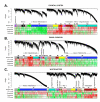Genetic, transcriptomic, and epigenetic studies of HIV-associated neurocognitive disorder
- PMID: 24583618
- PMCID: PMC3947559
- DOI: 10.1097/QAI.0000000000000069
Genetic, transcriptomic, and epigenetic studies of HIV-associated neurocognitive disorder
Abstract
The Human Genome Project, coupled with rapidly evolving high-throughput technologies, has opened the possibility of identifying heretofore unknown biological processes underlying human disease. Because of the opaque nature of HIV-associated neurocognitive disorder (HAND) neuropathogenesis, the utility of such methods has gained notice among NeuroAIDS researchers. Furthermore, the merging of genetics with other research areas has also allowed for application of relatively nascent fields, such as neuroimaging genomics, and pharmacogenetics, to the context of HAND. In this review, we detail the development of genetic, transcriptomic, and epigenetic studies of HAND, beginning with early candidate gene association studies and culminating in current "omics" approaches that incorporate methods from systems biology to interpret data from multiple levels of biological functioning. Challenges with this line of investigation are discussed, including the difficulty of defining a valid phenotype for HAND. We propose that leveraging known associations between biology and pathology across multiple levels will lead to a more reliable and valid phenotype. We also discuss the difficulties of interpreting the massive and multitiered mountains of data produced by current high-throughput omics assays and explore the utility of systems biology approaches in this regard.
Figures

Similar articles
-
Host genetic factors predisposing to HIV-associated neurocognitive disorder.Curr HIV/AIDS Rep. 2014 Sep;11(3):336-52. doi: 10.1007/s11904-014-0222-z. Curr HIV/AIDS Rep. 2014. PMID: 24996618 Free PMC article. Review.
-
Systems analysis of human brain gene expression: mechanisms for HIV-associated neurocognitive impairment and common pathways with Alzheimer's disease.BMC Med Genomics. 2013 Feb 13;6:4. doi: 10.1186/1755-8794-6-4. BMC Med Genomics. 2013. PMID: 23406646 Free PMC article.
-
Transcriptome analyses identify key cellular factors associated with HIV-1-associated neuropathogenesis in infected men.AIDS. 2017 Mar 13;31(5):623-633. doi: 10.1097/QAD.0000000000001379. AIDS. 2017. PMID: 28005686 Free PMC article.
-
Genomic Factors and Therapeutic Approaches in HIV-Associated Neurocognitive Disorders: A Comprehensive Review.Int J Mol Sci. 2023 Sep 21;24(18):14364. doi: 10.3390/ijms241814364. Int J Mol Sci. 2023. PMID: 37762667 Free PMC article. Review.
-
Human synaptic plasticity gene expression profile and dendritic spine density changes in HIV-infected human CNS cells: role in HIV-associated neurocognitive disorders (HAND).PLoS One. 2013 Apr 19;8(4):e61399. doi: 10.1371/journal.pone.0061399. Print 2013. PLoS One. 2013. PMID: 23620748 Free PMC article.
Cited by
-
ACT2.6: Global Gene Coexpression Network in Arabidopsis thaliana Using WGCNA.Genes (Basel). 2025 Feb 23;16(3):258. doi: 10.3390/genes16030258. Genes (Basel). 2025. PMID: 40149410 Free PMC article.
-
Multilevel analysis of neuropathogenesis of neurocognitive impairment in HIV.J Neurovirol. 2016 Aug;22(4):431-41. doi: 10.1007/s13365-015-0410-7. Epub 2015 Dec 4. J Neurovirol. 2016. PMID: 26637429 Free PMC article.
-
COMT Val158Met Polymorphism, Cardiometabolic Risk, and Nadir CD4 Synergistically Increase Risk of Neurocognitive Impairment in Men Living With HIV.J Acquir Immune Defic Syndr. 2019 Aug 15;81(5):e148-e157. doi: 10.1097/QAI.0000000000002083. J Acquir Immune Defic Syndr. 2019. PMID: 31107306 Free PMC article.
-
Iron-regulatory genes are associated with Neuroimaging measures in HIV infection.Brain Imaging Behav. 2020 Oct;14(5):2037-2049. doi: 10.1007/s11682-019-00153-0. Brain Imaging Behav. 2020. PMID: 31273671 Free PMC article.
-
Opposing regulation of endolysosomal pathways by long-acting nanoformulated antiretroviral therapy and HIV-1 in human macrophages.Retrovirology. 2015 Jan 22;12:5. doi: 10.1186/s12977-014-0133-5. Retrovirology. 2015. PMID: 25608975 Free PMC article.
References
-
- Navia BA, Jordan BD, Price RW. The AIDS dementia complex: I. Clinical features. Ann Neurol. 1986 Jun;19(6):517–524. - PubMed
-
- Bornstein RA, Nasrallah HA, Para MF, Whitacre CC, Rosenberger P, Fass RJ. Neuropsychological performance in symptomatic and asymptomatic HIV infection. Aids. 1993 Apr;7(4):519–524. - PubMed
-
- Schretlen DJ, Munro CA, Anthony JC, Pearlson GD. Examining the range of normal intraindividual variability in neuropsychological test performance. J Int Neuropsychol Soc. 2003 Sep;9(6):864–870. - PubMed
Publication types
MeSH terms
Grants and funding
LinkOut - more resources
Full Text Sources
Other Literature Sources
Medical

